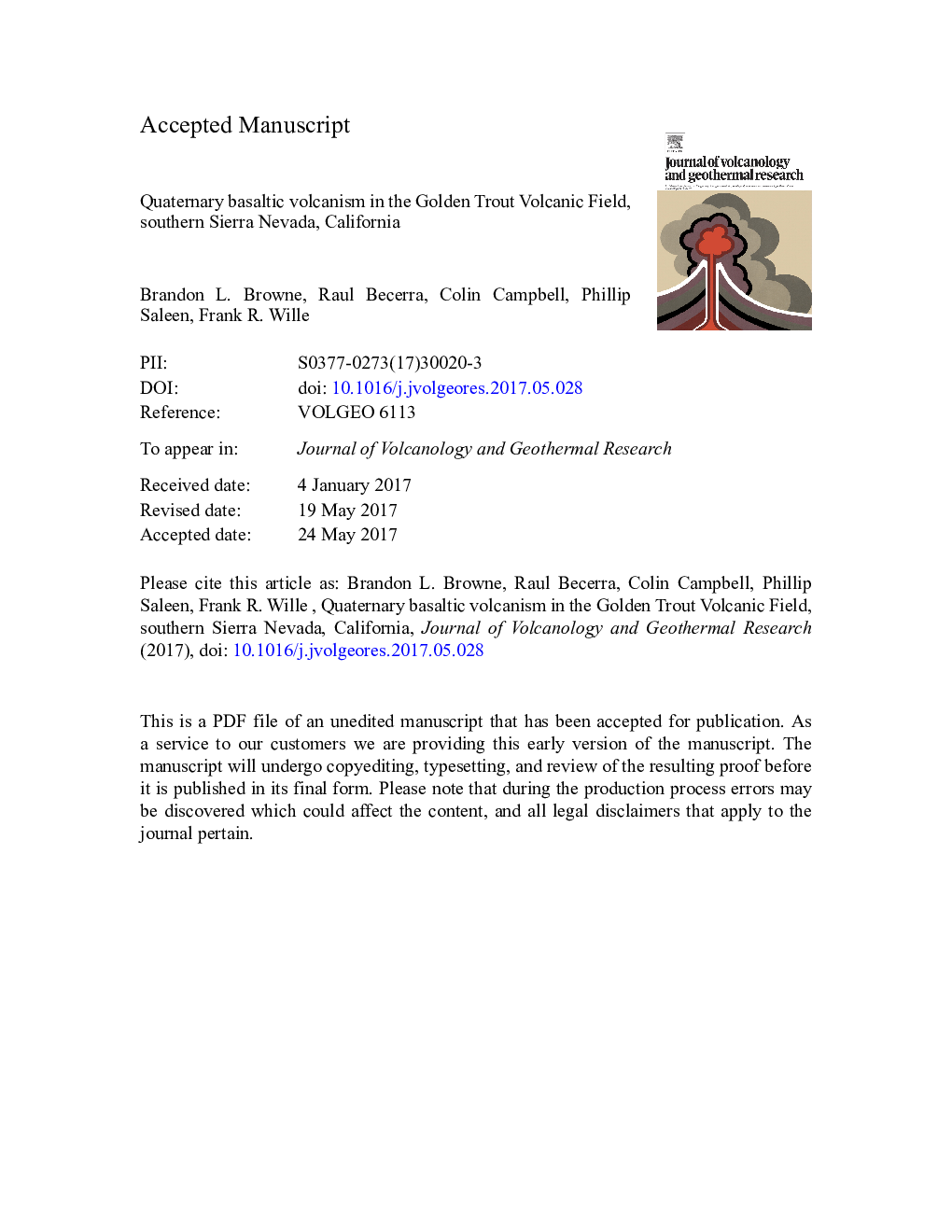| کد مقاله | کد نشریه | سال انتشار | مقاله انگلیسی | نسخه تمام متن |
|---|---|---|---|---|
| 5783686 | 1638280 | 2017 | 67 صفحه PDF | دانلود رایگان |
عنوان انگلیسی مقاله ISI
Quaternary basaltic volcanism in the Golden Trout Volcanic Field, southern Sierra Nevada, California
ترجمه فارسی عنوان
آتشفشانی بوزالکتومی کواترنر در فلوریدر آتشفشانی طلای قزل آلا، جنوب سیرا نوادا، کالیفرنیا
دانلود مقاله + سفارش ترجمه
دانلود مقاله ISI انگلیسی
رایگان برای ایرانیان
موضوعات مرتبط
مهندسی و علوم پایه
علوم زمین و سیارات
ژئوشیمی و پترولوژی
چکیده انگلیسی
The Golden Trout Volcanic Field (GTVF) produced the only Quaternary eruptions of mafic magma within the southern Sierra Nevada block. Approximately 38 Ã 106 m3 of basalt, trachy-basalt, basaltic trachy-andesite, and basaltic andesite (50.1-56.1% SiO2, 1.1-1.9% K2O, and 5.4-9.1% MgO) was erupted from four vents within a ~ 10 km2 portion of the GTVF, which also includes rhyolite domes that are not considered in this study. The vents include, from oldest to youngest: Little Whitney Cone, South Fork Cone, Tunnel Cone, and unglaciated Groundhog Cone. Little Whitney Cone is a 120 m-high pile of olivine-CPX-phyric scoria produced during a Strombolian-style eruption overlying two columnar jointed lava flows. Tunnel Cone formed through a Hawaiian-style eruption along a 400 m-long north-south trending fissure that excavated at least three 25-65 m-wide craters. Crater walls up to 12 m high are composed of plagioclase-olivine-phyric spatter-fed flows that dip radially away from the crater center and crumble to form Tunnel Cone's steep unconsolidated flanks. South Fork Cone is a 170 m-high pile of plagioclase-olivine-phyric scoria that formed during Strombolian to violent Strombolian eruptions. South Fork Cone overlies the South Fork Cone lava, a 9.5 km-long flow (~ 12 Ã 106 km3) that reached the Kern River Canyon to the west. Scoria and airfall deposits originating from South Fork Cone are located up to 2 km from the vent. Groundhog Cone is a 140 m-tall cinder and spatter cone breached on the north flank by a 13 Ã 106 m3 lava flow that partially buried the South Fork Cone lava and extends 7.5 km west to Kern River Canyon. Incompatible trace element concentrations and ratios show vent-specific trends but are unsystematic when plotted in terms of all mafic GTVF vents, implying that GTVF basalts were derived from a lithospheric mantle source and ascended through thick granitic Sierra Nevada crust as discrete batches that underwent different degrees of crustal contamination, differentiation, and magma mixing. Clinopyroxene-liquid thermobarometry calculations of the oldest and most primitive GTVF sample indicate that most clinopyroxene crystals record nucleation conditions of 1172-1196 °C and 896-1115 MPa. These pressures correspond to depths equivalent to, or up to 10 km shallower than, the Moho in this region. Deposits from the oldest GTVF vents are more primitive and homogeneous in terms of major and trace element concentrations, phenocryst textures and compositions, and their general absence of crustal xenoliths and xenocrysts compared to younger eruptive products. The eruption rate of the GTVF (~ 0.05 km3/Myr) is two orders of magnitude less than neighboring and contemporaneous Big Pine and Coso volcanic fields to the north and east, respectively. We interpret these differences to result from a relative lack of strain in the GTVF region of the southern Sierra Nevada block, which limits magma accumulation and ascent.
ناشر
Database: Elsevier - ScienceDirect (ساینس دایرکت)
Journal: Journal of Volcanology and Geothermal Research - Volume 343, 1 September 2017, Pages 25-44
Journal: Journal of Volcanology and Geothermal Research - Volume 343, 1 September 2017, Pages 25-44
نویسندگان
Brandon L. Browne, Raul Becerra, Colin Campbell, Phillip Saleen, Frank R. Wille,
